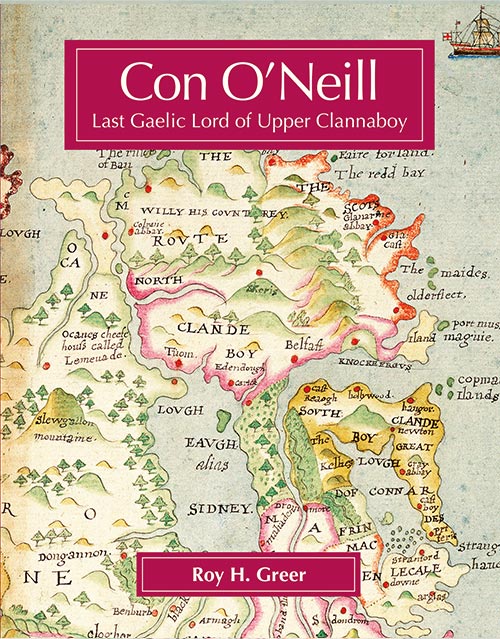
Con O'Neill
Last Gaelic Lord of Upper Clannaboy
Roy H. Greer
£14.95
This exciting new work commemorates the four hundredth anniversary of the death of Con O’Neill, whose passing marked the end of the Gaelic way of life in Ulster.
Author Roy Greer describes the publication as his ‘ten-year journey with an Irish chief’.
‘As an East Belfast boy, I was only vaguely aware of Con O’Neill, who has given his name to the Connswater Shopping Centre, Connsbrook Avenue and ‘the Connsie’ river.’
‘Long hours spent in the Linen Hall Library, the Public Record Office, and at Queen’s, and trailing through old archives and Calendars of State Papers on the internet soon revealed that little had been written on him or the people he led, the Clannaboy. What I discovered was a tale to rival Game of Thrones!’
The book falls into three main sections; the first traces the bloody rise of the Clannaboy, who in the fourteenth and fifteenth centuries drove the Normans almost entirely out of eastern Ulster. The Clannaboy conquered a huge territory in Antrim and Down, which they held against all comers until the beginning of the seventeenth century.
‘More than a million people now live in what was once the great medieval lordship of Clannaboy,’ says Roy, ‘and I doubt that a dozen of them even know it!’
The second section focuses on the part of Clannaboy known as Upper Clannaboy. It reached from Lisburn through Drumbo, Lambeg and much of South and East Belfast, to Holywood, Dundonald, Newtownards, Bangor and Donaghadee, and down the Ards Peninsula to the Saltwater Brig, taking in the modern towns of Comber, Ballygowan, Crossnacreevy, Saintfield, Moneyrea and Carryduff, a substantial territory.
The lords of Upper Clannaboy controlled their lands from their tower house of Castle Reagh. Con O’Neill was their last ruler.
‘He was a complex, flawed character, who lived at an absolutely seminal moment in Irish history. He was totally out of his depth as he struggled to cope with huge historical forces that were really beyond anyone’s power to manage,’ explains Roy. The end of the Nine Years War saw the death throes of the Gaelic way of life and the coming of the Ulster Scots. The third section describes how the settlers transformed local life.
‘This is a fascinating, complex story,’ says Roy. ‘And Con is undoubtedly an intriguing figure. But this is not just the story of a man, or even a clan. Nor is it a straightforward narrative of dispossession, or the story of a clash of nations. It is about something even more fundamental than that, it is about a collision between two historical epochs, and about how capitalism, red in tooth and claw, turned a feudal society on its head. And it all comes together in Con's life.’
‘It is also my hope that bringing the stories of Con O'Neill and the Ulster Scots together in one volume will encourage us to embrace our shared history.’
The book has been published with the kind support of Lisburn and Castlereagh City Council.
Book Details
ISBN 978 1 870132 51 0
Paperback 232 pages, colour illustrated
Book Reviews
'Impressively researched and richly illustrated' Belfast Telegraph
'Hopefully this handsome, 232 page, colour illustrated book will help restore Con and his clan to the heart of the history eastern Ulster.' Belfast News Letter
'Fast moving... a fascinating tale of love and war, possessions and land grabs... A very fine book both in content and presentation... richly illustrated with maps, portraits and manuscripts, together with high quality colour photographs' Irish News
Other local history books
- Portavo: an Irish Townland and its peoples Part one: earliest times - 1844
- Portavo: an Irish Townland and its peoples Part two: the famine to the present
- Two Centuries of Life in Down, 1600-1800
- Newtown, A History of Newtownards
- The Most Unpretending of Places A History of Dundonald, County Down
- Donaghadee: An Illustrated History
- Yes, Matron
